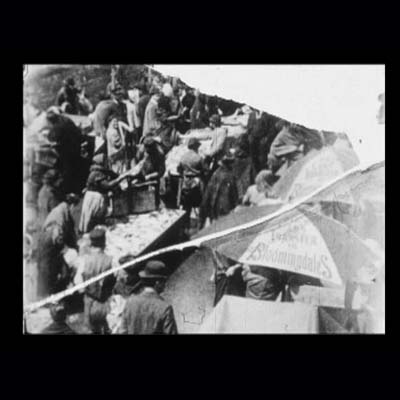The September 2012 issue of the Journal of the Society of Architectural Historians contained my review article that discussed a movies and websites I termed "place compilations," specifically ...
- Los Angeles Plays Itself ( Thom Anderson, 2003)
- Of Time and the City: A Love Song and a Eulogy( Terence Davies, 2008)
- A Film Unfinished (Yael Hersonski, 2011)
- Home Movie Day events worlwide
- New York Ghetto Fishmarket 1903 (Ken Jacobs, 2007)
- The Life of a City: Early Films of New York, 1898–1906 (Library of Congress)
- Moving History regional moving image archives of the UK
- Electric Edwardians: The Lost Films of Mitchell and Kenyon by Sagar Mitchell, James Kenyon (Oscilloscope Laboratories/Milestone Films, 2009)
- Peoples’ Stories: Liverpool Lives
The full text is available via Jstor, but it begins ...
During the last decade, there have been a number of attempts to reconstruct historic places by assembling old film and video footage. This use of this material provides architectural and urban historians with new documents and an innovative vehicle for scholarship. While mainstream documentary film traditions have focused on capturing the present—especially in the classic city films such as Manhatta (Charles Sheeler & Paul Strand, 1921) and Chelovek s kinoapparatom/Man with a movie camera (Dziga Vertov, 1929)—an alternative tradition focused on capturing the past has also flourished.
In his 1964 monograph Films beget films, Jay Leyda formulated the term “compilation film” for this genre. The compilation film, according to Leyda, originated in 1898 when Francis Doublier assembled unrelated Lumière shorts into a bogus documentary of the Dreyfuss case. The form reached an early peak in The Fall of the Romanov Dynasty (Esther Schub, 1927), and flourished during World War II (The True Glory, Reed & Kanin, 1945, and the Why We Fight series, Frank Capra, 1942-5). Post-war, NBC’s Victory at Sea (1957) established a compilation format which remains the default style of history documentaries on TV.
In the last ten years, the format has come into vogue again in theaters. The movies discussed here illustrate some currently popular approaches to urban historiography via archival footage, which might be categorized as Credulous, Critical, Appropriative, or Investigative. ...
[Image: still from New York Ghetto Fishmarket 1903 (Ken Jacobs, 2007)]
